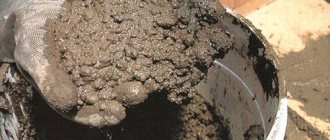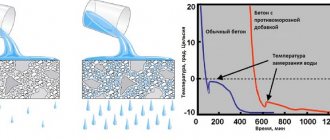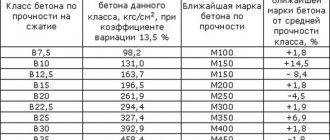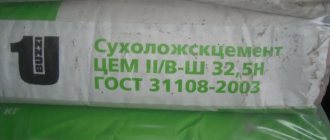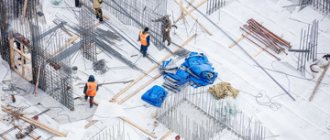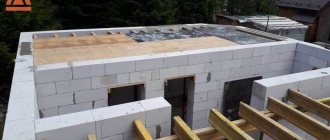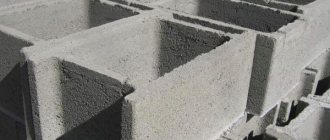In what cases are supplements needed?
Depending on the location and operating conditions, concrete structures must meet certain requirements. Some are designed to withstand enormous loads, others – not to collapse from constant contact with water, others – to be resistant to abrasion, etc. Concrete additives help give them the desired properties. They are used in a variety of cases:
- during the construction of monolithic structures;
- when installing floors and coverings with high load-bearing capacity;
- when creating thin-walled or densely reinforced structures;
- during the construction of hydraulic structures;
- in the manufacture of such small-piece products as wall and facing blocks, paving slabs, paving stones, curbs;
- when carrying out work at sub-zero temperatures or in extreme heat.
Paving slabs must withstand mechanical and temperature loads, be resistant to abrasion and water. Source wixstatic.com
In addition, additives to concrete to increase strength, workability or mobility are used to prepare repair and plastering mortars, mortars based on porous or non-standard aggregates.
Types of additives for concrete
There are two types of concrete additives: liquid and powder. They mainly affect the specific properties of the fresh mortar - workability, the onset of hardening. Additives to concrete must be added either to the mixing water or to the finished mixture.
There is a separate type of specific additives - air-entraining, foaming. For example, the concrete additive calmatron d. This type of modifier has a complex effect. It is added to improve several parameters at the same time. The concrete additive significantly reduces costs and avoids the incompatibility of several individual additives.
Hardening accelerators and retarders are also important. Popular additives for concrete in this category are calcium chloride, sodium sulfate, calcium and sodium nitrates. Multicomponent compositions include: nitrite-calcium nitrate, nitrite-nitrate-calcium chloride. Below is the type classification of additives.
Return to contents
Modifiers
Complex protein modifier "Biotech".
Modifying compounds are a category of substances that improve strength, durability, and resistance to low temperatures. They reduce the permeability of concrete. It is more convenient to work with the modified product, as its mobility improves. The solution spreads evenly, filling all the cracks and depressions.
Modifiers are classified according to the purpose of the resulting concrete. For example, there are additives to concrete intended for the construction of wells and swimming pools. Another type of additive is used in the construction of facades or the formation of floor screeds. Such a regulator, which improves the performance qualities of the building mass, reduces its moisture permeability.
Return to contents
Plasticizers
This group is the most in demand. There are four categories of plasticizers:
- Strong.
- Weak.
- Average.
- The latest superplasticizers.
Additives in the last category include substances for a comprehensive solution to the assigned tasks, increasing several characteristics of the cement mass. Depending on the scheme of action on concrete and the chemistry of the process, plasticizers are:
- Increasing mobility with a constant amount of water.
- Reducing cement consumption by up to 10% without changing mobility.
- Increasing strength with constant mobility.
The additives have the following benefits:
- saving consumables;
- improving the mobility of sand-cement;
- increase in reliability by 20-25%;
- production of workable mass;
- possibility of pouring thin-walled or densely reinforced structures;
- compaction of cement composition;
- improvement of frost resistance and crack resistance;
- saving energy resources by reducing the time for obtaining cement mass.
The disadvantage of plasticizers is the acceleration of the hardening rate. Therefore, additional chemicals for concrete are recommended to speed up this process. The resulting concretes are widely used in structures where perfectly smooth floors and walls are needed.
Return to contents
Anti-frost
Additives for concrete and mortars are necessary to lower the freezing point of water, which is included in their composition. Chemistry that increases the anti-frost characteristics of these products facilitates the process of laying mortar and speeds up the process of concrete gaining strength in the cold season. These indicators allow you to save consumables and extend the service life of the finished product. The cements acquire frost-resistant properties. Sodium nitrite is the most popular additive. Other air-entraining components are also available.
Return to contents
Mobility regulators
These specific additives, added to maintain the plasticity of the solution in unfavorable conditions, are actively used in the hot summer. Concrete regulators are also suitable for long-term transportation of mortar. Regulators improve the convenience of mortars when laying floor screeds.
Return to contents
Additives to concrete to increase strength
One type of complex-action additives is strength gain accelerators or concrete hardeners. They are endowed with the qualities of both superplasticizers and hardening accelerators. They contain organic and inorganic compounds without alkalis. Accelerators have a wide range of use in construction, industry, road and transport sectors when obtaining a marketable product or in areas where gunite concrete is needed.
Return to contents
Chemical additives
There are several target categories of chemical additives mixed into the concreting solution. The classification is made according to the effect they have.
- Concrete modifiers of mobility and plasticity of the mixture.
- Substances to reduce moisture evaporation from solution.
- Waterproofing additives.
- Concrete stabilizers for the process of delamination of sand-cement mass.
- Hardeners.
- Set retarders.
- Antifreeze additives.
- Foam and gas formers.
- Protective connections.
- Air-entraining compounds.
- Concrete additives that improve resistance to corrosion and exposure to living organic matter (mold, fungi).
- Water repellents.
Chemical substances can affect several properties, but only one will appear. The principle of action of additives is similar to the action of surfactants and can form a material with a spatial structure. This category includes additives based on nitrite compounds. Such chemistry is very dangerous, so you need to work with it carefully, following the instructions from Skytrade.
Return to contents
Anti-corrosion
Modifying products impart resistance to concrete when exposed to fresh filter water, an aggressive liquid that causes corrosion of the material. These concrete additives solve several problems:
- prevent the dissolution of the components of the finished stone;
- prevent the leaching of reaction products of concrete and water;
- protect the surface from crystalline, poorly soluble formations that lead to the destruction of the stone.
During the action of anti-corrosion chemicals, free calcium hydroxide in concrete is completely or partially bound. The additive is mixed in to increase the density and moisture resistance of the stone and reduce the volume of pores in its structure. Due to this, cements are endowed with hydrophobicity.
NitCaL is a specially developed nitrate to accelerate the development of strength, crack resistance, the production of high-quality monoliths and reinforced concrete products, and the prevention of corrosion processes in reinforcement in concrete.
Return to contents
Additives for self-compacting mixtures
A specific type of additives is used when pouring thin-walled structures. This category includes some new superplasticizers that improve the mobility of the building mass and the reliability, density and water resistance of the finished product. Concrete regulators allow you to reduce cement consumption without losing the quality of the resulting structure. Chemical modifiers of this type increase the grade of the mixture and the rate of strength gain at the initial stage of hardening.
Complex additives for thin-walled and densely reinforced products greatly simplify the process of selecting the necessary components and determining their compatibility. Stabilizing superplasticizers are designed to solve several problems by adding only one substance. Their goal is to obtain the maximum effect from interaction with the components of the mixture.
Return to contents
Classification of additives
Among the additives produced, there are both products that affect the change of only one or two properties of concrete, as well as complex multifunctional additives. There are several main groups.
- Plasticizing agents – improve the mobility and plasticity of concrete mortar, reduce the amount of cement required for its preparation, and reduce the risk of shrinkage cracks.
- Accelerating hardening - this additive is used in concrete to increase strength and reduce the time required to build it.
- Water-reducing - allow you to reduce the amount of water for preparing the concrete mixture and provide it with increased density and frost resistance.
- Antifreeze - maintains normal reactions in the concrete solution necessary for hardening at sub-zero temperatures.
- Regulating mobility - maintain the fluidity and plasticity of concrete during long-term transportation or laying in hot weather.
When transported over long distances, concrete should not lose its properties Source ru-beton.ru
- Modifying - affecting several characteristics at once.
Types of cement mixtures
Depending on the composition and purpose of use, the solution is divided into brands:
- M150 and M200 – for screeds;
- M50, M100, M150, M75, M200 and M125 - for masonry;
- M10, M50 and M25 - for plaster.
All varieties differ in the quantitative sand content and proportions. Changing the ratio of the main components allows the use of such building material for various jobs.
The grade of mortar is an indicator of the strength of the structure built using it. The proportions of the ingredients usually depend on what brand of cement mortar is needed. Often, cooking instructions are printed by the manufacturer on the packaging.
Of course, you can order a ready-made mixture of the desired brand (currently they sell dry ready-made mixtures for foundations, plaster or screed, to which you just need to add the required amount of water). But mixing it yourself will save you money.
Characteristics and use of various additives
To decide what to add to concrete for strength, hydrophobicity or accelerated hardening, you need to understand the variety of additives.
Plasticizers
The purpose of using plasticizing additives is to improve the spreadability and mobility of a fresh solution by thinning the mixture without increasing the volume of water. Additional advantages are increasing the density, strength and uniformity of concrete, obtaining a high-quality smooth surface, and reducing labor costs when pouring.
In stores you can find such concrete additives called “Plasticizer” and “Superplasticizer”. The use of superplasticizers makes it possible to obtain mixtures with higher mobility and flow rates that are 6-7 times higher than usual. Substances for intensive strength gain are often introduced into their composition.
Superplasticizer for concrete Source virashop.ru
It is important! Plasticizing additives are introduced into the concrete mixture in strict accordance with the recommended dosages to prevent the solution from slipping.
The use of such additives is relevant for the manufacture of:
- monolithic densely reinforced structures;
- concrete industrial coatings and screeds with high loads;
- reinforced concrete products - wall panels, floor slabs, etc.;
- piece products made of sand concrete;
- repair and masonry mortars.
See also: Catalog of companies that specialize in repairing foundations of any complexity
Hardening accelerators
Often, to reduce construction time, you have to decide how to increase the strength of concrete without waiting for the standard 28 days to continue work. It is known that ordinary concrete gains grade strength during this period, during which it cannot be loaded. Such long technological pauses in work are not beneficial for either customers or contractors.
The need to reduce the hardening rate arises when pouring screeds, foundations, monolithic walls and ceilings, manufacturing paving slabs and cinder blocks, bricklaying with cement mortar and in many other cases.
Accelerators in the form of powder and aqueous solution Source beton-house.com
The effect of this strength additive in concrete is to activate the chemical reactions of cement hydration. Its introduction allows:
- increase the primary (stripping) strength of concrete by 20-40%;
- increase its brand strength by 10-20%;
- increase the mobility of the mixture;
- extend the service life of concrete structures.
Some additives in this group reduce the time required to gain brand strength to 7-10 days, allowing construction and installation work to continue much earlier than in a normal situation.
Video description
Watch a video testing paving slabs made with and without a hydrophobic additive:
Other Supplements
Additives to cement can have other purposes, have a special or complex effect.
- Anti-corrosion additives give concrete resistance to acids and poorly soluble compounds, protect reinforcement and elements of removable and permanent formwork, and other metal structural elements in contact with concrete from rusting.
- Additives that improve the self-compaction of concrete make it possible to create thin-walled products and structures with a large number of reinforcing elements.
- Air-entraining additives slow down the evaporation of moisture from molding products, stimulating complete hydration of the cement.
- Multifunctional chemical additives for concrete have a complex effect and improve several of its characteristics at once.
Complex waterproofing additive Source promindex.ru
How to change the properties of concrete using improvised means
People have always thought about improving the strength and durability of hardening building mixtures. There is information that in the old days masonry and plaster mortars were mixed using chicken eggs, which made them more dense, flexible and durable. It is difficult to say whether this is true, and it is unlikely that modern developers will incur such expenses.
However, many craftsmen believe that household detergents, rather than special chemicals, can be added to cement for strength and ductility. Less expenses, but the same result. Dishwashing detergents, liquid soap or washing powder dissolved in water are used as household plasticizers.
Fairy is the most popular home plasticizer Source setam.net.ua
Everyone knows that salt prevents water from freezing. And they apply this knowledge when mixing concrete in winter, increasing its frost resistance with the help of ordinary table salt. The main thing here is not to overdo it and not to add more than 2% of the volume of the dry mixture.
Briefly about the main thing
Concrete can have different characteristics depending on the brand of cement, the proportions of its components, the correct preparation, and the maturing conditions. These characteristics can be changed at your discretion, if you know that there are special additives for concrete: for strength, for increasing ductility and hardening speed, for resistance to water and low temperatures. The introduction of a small amount of these substances into the solution makes it possible to simplify concrete work and increase the durability of buildings, structures and concrete products.
Ratings 0
How to use and dilute plasticizer
There is not and cannot be a universal answer on how to add a plasticizer. Each manufacturer independently determines the content of additives in its own product, which, accordingly, changes the consumption per volume of the mixture. Therefore, it is very important to study the manufacturer’s recommendations and strictly adhere to them when producing the solution.
The requirement to dilute the plasticizer with water before adding it to the solution can be considered universal. Depending on the required properties of the solution, the plasticizer consumption can be determined based on the content of surfactants in it - from tenths to 2-3% of the total volume. The consumption of plasticizers also depends on the place of production of the mixture. If transportation is necessary, the consumption of plasticizers must be increased; when preparing immediately before pouring, it must be reduced to the value necessary to maintain the water-cement ratio.
